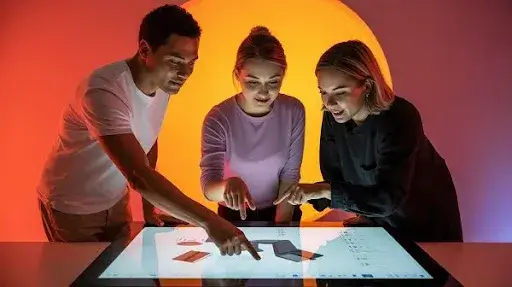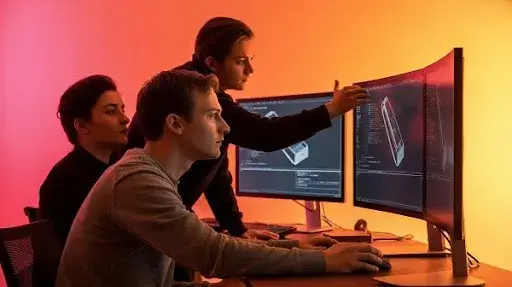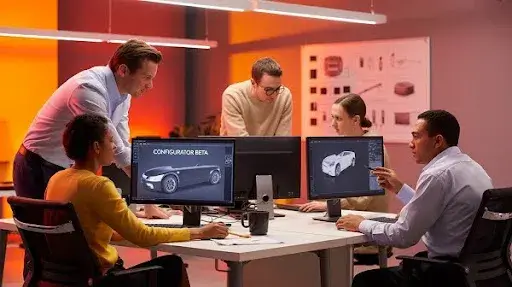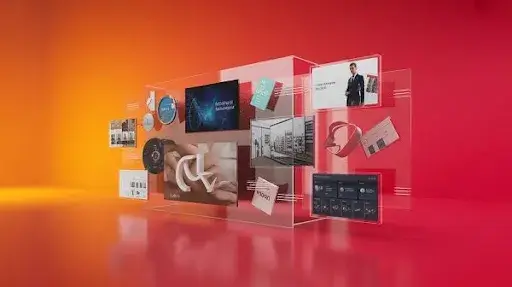Buying online isn’t what it used to be. A decade ago, you had to flip through endless static images, guess at colors, and trust that a product description wasn’t stretching the truth. Shoppers today won’t settle for that. They want freedom to tweak, rotate, and preview — almost like having the product in their hands before paying for it.
This is where 3D product configuration steps in. It’s not some flashy add-on. For many brands, it’s turning browsers into buyers. The big question is simple: is it worth putting your money into this technology?
What Exactly is 3D Product Configuration?
Think of it as an interactive showroom built right into your website. A 3D product configuration tool lets buyers spin a product around, zoom in, and swap options in real-time. They can try different materials, adjust sizes, or switch colors. The display changes instantly, sometimes even updating the price on the spot.
A report estimated the total 3D Product Configurator market (software and services) at USD 1.98B in 2024, projecting a CAGR of approximately 20.7%, and predicting around USD 8.16B by 2033.
Instead of scrolling through 20 photos for each option, you show shoppers a 3D model of your custom products that covers it all. That’s a massive step up in clarity and user experience.
Take furniture retail as an example. Instead of one image of a chair in gray, a configurator gives shoppers the ability to flip through fabrics, adjust leg finishes, and view it from every side. That hands-on freedom reduces doubt — and doubt is the number one reason people walk away from their carts.
Why People Care About Product and Customization
Customers don’t just want to buy; they want to feel like they’ve had a say in the outcome. Static pages fall short of that. The option to customize products brings the shopping experience closer to what people expect in-store.
Here’s why it matters:
- Confidence – Seeing the end result before purchase reduces guesswork and cuts down on buyer’s regret.
- Personal touch – A customized product feels more “mine.” Even small tweaks create emotional value.
- Shopping enjoyment – Customization turns shopping into play. It feels engaging, not like ticking boxes.
That mix of trust and enjoyment drives people to finish checkout instead of bouncing away.
How a 3D Product Configurator Actually Works
Behind every smooth configurator are two main components:
- 3D models of your custom products – These digital builds replace the need for hundreds of product photos. Once you have a model, it can display all variations dynamically.
- The interface – This is the dashboard customers see. They pick colors, sizes, or add-ons, and the model reacts immediately.
The clever part is the logic running in the background. It keeps shoppers from choosing combinations that don’t work — for instance, a sofa fabric that isn’t available with a certain frame. That prevents frustration and keeps the buying process straightforward.
Building a 3D Product Configurator
If you’re wondering how to build a 3D product configurator, there’s more than one approach.
- Developing a product configurator in-house – Best if you have an experienced dev team and want full ownership. But remember, you’ll also carry the burden of maintaining it long term.
- Creating a product configurator with Excel – Sounds odd, but some small businesses do it to map out pricing or combinations before scaling. It’s a basic stepping stone, not a final solution.
- End-to-end product configurator solutions – Third-party platforms offer ready-made systems. They plug into your eCommerce site, manage updates, and often provide analytics. It’s the fastest way to get started if time and technical skills are limited.
Each route comes with pros and cons, but the aim is the same: make the buying experience as interactive and clear as possible.
Why Add 3D Product Configuration to an eCommerce Platform?
A product configurator for your eCommerce platform isn’t just decoration. It directly tackles pain points that cost businesses money:
- Cart abandonment – When buyers can’t visualize the product, they back out. A configurator bridges that gap.
- Returns – Misunderstandings about size, color, or features often lead to returns. With a configurator, customers see exactly what they’re ordering, which cuts that risk.
- Competition – Many stores still rely on static pages. Offering exceptional product configuration instantly sets your shop apart.
For industries like furniture, cars, electronics, or fashion, this feature is becoming less of an option and more of an expectation.
Business Benefits of 3D Configuration for Product Customization
Let’s look at what companies actually gain from using 3D configuration for product customization.
More Conversions
People buy more when they can shape the product. Interactive visuals reduce hesitation and create trust, which translates into higher conversion rates.
Larger Orders
The configurator can spotlight premium add-ons — a better finish, a larger size, or a more advanced feature. Customers often upgrade once they see the difference, boosting average order value.
Fewer Support Requests
Customers don’t have to email support to ask what “charcoal gray” looks like or if a certain frame pairs with a fabric. They can see it instantly, which saves staff time.
Stronger Engagement
An interactive tool keeps customers on your site longer. That extra time builds brand recall and increases the chance of a sale.
Why 3D Product Animation Services Are Critical
The visual quality of your configurator makes or breaks the experience. Grainy or unrealistic images can make products look cheap. This is where high quality 3D product animation services step in.
With sharp, photorealistic visuals, every material and finish looks convincing. That level of detail reassures shoppers and drives sales. It also helps your brand look more professional compared to competitors who stick with flat photos.
Should You Develop a Product Configurator In-House?
Some companies want total control and try to develop a product configurator in-house. That approach works for businesses with a dedicated technical team and budget for ongoing support. But it’s not a small project — updates, bug fixes, and model creation all require constant resources.
For most small and mid-sized businesses, relying on end-to-end product configurator solutions is usually smarter. Outsourced systems come with expert support, cost less upfront, and allow your team to focus on running the business instead of debugging code.
The Real Business Impact of Exceptional Product Configuration
Done right, exceptional product configuration affects the bottom line in three big ways:
- Revenue growth from higher conversion rates and upselling.
- Lower costs because fewer products come back and support spends less time answering repetitive questions.
- Market insights from the data. Every click, preference, and customization choice tells you what customers actually want.
That data is often overlooked, but it’s valuable. For example, if most shoppers ignore a certain material, maybe it’s not worth keeping in stock. If a particular add-on gets chosen frequently, it could deserve more marketing.
Why Customized Products Carry Extra Weight
There’s a simple truth in retail: when people design something, they value it more. A customized product feels personal, even if the core design is shared with thousands of others. That sense of ownership is why people happily pay more for personalized options.
By offering customization through a configurator, you’re not just selling a product. You’re selling the pride that comes with saying, “I made this the way I wanted.” That emotional pull keeps customers coming back.
Examples of 3D Product Configuration in Action
Plenty of well-known companies have already embraced the technology:
- Car manufacturers let buyers configure trims, wheels, and interiors before stepping into a dealership.
- Furniture sellers show couches in every possible layout and finish, so customers can design for their space.
- Tech brands offer customization of laptops, letting customers pick memory, storage, and accessories.
In each case, the outcome is the same: customers spend more time on the site, they make faster decisions, and they walk away happier with their purchase.
The ROI of 3D Product Configuration
Nobody puts money into new tools just for show. Every dollar needs to earn its way back. That’s exactly what 3D product configuration does. It’s not another shiny add-on—it’s a real shift in how people shop, and you can see it in the numbers.
When buyers take charge and customize products themselves, a couple of things usually happen:
- Cart abandonment drops.
- Returns shrink.
That alone saves a company a chunk of money. But the bigger surprise is in upgrades. As customers test out different finishes or features, many end up choosing the premium version. No sales rep needed. The configurator lays it all out visually, and shoppers decide the extra cost feels worth it.
There’s another angle: data. Every click tells you something—what sells fastest, what never gets picked, and what upgrades buyers happily pay for. That feedback doesn’t just improve marketing; it can shape future product decisions too.
Why 3D Product Configurators Go Beyond Sales
Yes, they drive more sales, but the ripple effects are bigger than that. A good configurator streamlines operations, trims waste, and even helps cut marketing spend.
Smarter Stock Management
Instead of guessing which colors or styles will sell, you see demand in real time. That means fewer shelves filled with items no one wants and more stock of the ones flying off screens.
Marketing With Precision
When you know what people click on most, campaigns practically write themselves. If 70% of buyers keep choosing a certain fabric, that fabric should headline your next ad. It’s targeting backed by data, not guesswork.
Lower Costs for Customer Acquisition
Happy shoppers talk. A buying experience that feels smooth builds trust, and that trust often turns into referrals. Fewer dollars go into chasing new customers, because your old ones bring them to you.
So the real payoff of exceptional product configuration isn’t just sales—it’s efficiency across the board.
Ways to Build a 3D Product Configurator
Decided you need one? Good. Now the bigger question is: how do you build it? Different paths come with very different commitments.
Developing In-House
The upside: you own everything. The look, the logic, the data—it’s all in your hands. You can tweak or update it whenever you want.
The downside: it’s expensive. Skilled developers don’t come cheap, and projects like this almost always drag out longer than expected. If your team hasn’t built 3D models or dealt with this kind of tool before, expect delays.
Using Excel for Testing
Yes, you can build early prototypes with Excel. It’s fine for testing rules or setting up pricing logic. But that’s where it ends. It’s not something you’d roll out to paying customers.
Outsourcing With End-to-End Solutions
For most businesses, this is the most practical choice. Providers that specialize in end-to-end product configurator solutions deliver polished setups that plug right into eCommerce platforms like Shopify or WooCommerce. You get speed, expert support, and tracking tools all built in.
Industries Winning With 3D Configuration
Some sectors are already seeing big returns:
- Furniture: Sofas, chairs, and tables in endless combinations.
- Automotive: Cars with custom trims, wheels, and add-ons.
- Fashion: Shoes, jackets, and accessories tweaked to personal taste.
- Electronics: PCs, laptops, and phones customized to specs.
- Home Décor: Rugs, lamps, and artwork tailored to the look of a room.
The pattern is easy to see: the higher the product’s value or complexity, the stronger the case for a configurator.
Why High Quality 3D Product Animation Services Matter
A configurator is only as good as what buyers see. If the visuals look flat or fake, trust disappears. No one spends hundreds—or thousands—on a product that looks like a rough sketch.
That’s where 3D product animation comes in. Clean textures, accurate lighting, smooth movement—all of that makes a digital model feel close to real life. When customers can rotate, zoom, and test variations without losing detail, confidence skyrockets. That confidence carries through to checkout.
The Future of 3D Product Configuration
Today, it feels like an upgrade. Soon, it’ll just be standard. Once shoppers get used to customizing, going back feels like a step down.
We’re already seeing what’s next:
- AR tools that let you place a sofa in your living room before buying.
- AI recommendations that guide you toward the options that fit your taste.
- Faster rendering that makes even complex changes feel instant.
Businesses that wait too long risk falling behind. Early adopters don’t just stand out—they define customer expectations.
Frequently Asked Questions
How much does it cost to build a configurator?
In-house builds can run into six figures. Outsourced solutions often charge monthly fees, which makes them easier to budget.
Is it only for big companies?
No. Small and mid-sized businesses can see great returns, especially since configurators cut down on returns and boost confidence.
Which industries see the highest ROI?
Furniture, automotive, fashion, and electronics lead the way, but any customizable product can benefit.
Can Excel be used to build one?
Excel works for testing pricing or compatibility rules. It’s not suited for customer-facing tools.
How do you get 3D models of your custom products?
Most come from CAD files or pro 3D modeling software. For realistic visuals, skilled designers or high quality animation services are a must.
What’s the trade-off between in-house and outsourcing?
In-house builds give you control but cost a lot more and take longer. Outsourcing delivers faster results with less stress.
Final Words
Yes. And the payoff goes further than most people expect. 3D product configuration makes shopping easier, reduces returns, raises order values, and feeds you data that can shape smarter business moves.
The biggest advantage? Customers feel in control. That sense of ownership leads to more purchases—and repeat ones too.
At Prolific Studio, one of the best animation studios in Georgia, we specialize in helping brands build 3D product configurators backed by high quality 3D product animation services. If you’re ready to move beyond static product pages and give your customers an experience they’ll remember, now’s the time to act.










